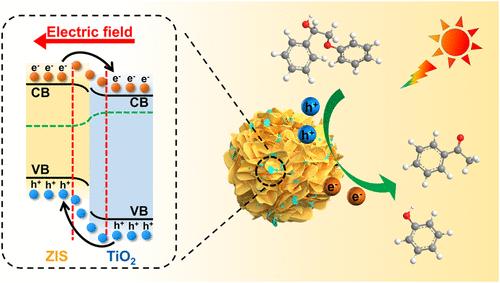Solar-Driven Selective Photocatalytic Self-Hydrogen Transfer Cleavage of Lignin Models by a ZnIn2S4/TiO2 Heterojunction with Efficient Internal Electric Field
IF 3.9
3区 工程技术
Q2 ENGINEERING, CHEMICAL
引用次数: 0
Abstract
Photocatalysis under mild conditions has been demonstrated as an effective way of depolymerizing lignin to produce aromatic monomers. However, challenges still persist in light absorption, charge separation, and charge utilization. The efficiency and selectivity of lignin cleavage still require further improvement. In response to these challenges, a type-II heterojunction ZnIn2S4 nanoflowers/TiO2 nanosheets (ZT) was used to selectively break the Cβ–O bond of β-O-4 linkage under solar illumination. The best conversion rate is 98%, with almost no intermediate product formed, and the yields of main products are 85 and 67%, respectively. According to the material characterization results, the establishment of heterojunction enhances the catalyst light absorption range and forms a powerful internal electric field and efficient type-II electron transfer pathway. Therefore, ZT heterojunction enhances charge separation efficiency, playing a crucial role in breaking the Cβ–O bond. This study offers a promising strategy for the future development of photocatalytic lignin value-added conversion.

高效内电场ZnIn2S4/TiO2异质结对木质素选择性光催化自氢转移裂解模型的影响
温和条件下的光催化是木质素解聚制备芳香单体的有效途径。然而,在光吸收、电荷分离和电荷利用方面仍然存在挑战。木质素裂解的效率和选择性有待进一步提高。为了应对这些挑战,利用ii型异质结ZnIn2S4纳米花/TiO2纳米片(ZT)在太阳光照下选择性地破坏β-O-4键的c - β- o键。最佳转化率为98%,几乎不形成中间产物,主要产物收率分别为85%和67%。根据材料表征结果,异质结的建立增强了催化剂的光吸收范围,形成了强大的内部电场和高效的ii型电子转移途径。因此,ZT异质结提高了电荷分离效率,对c - β - o键的断裂起着至关重要的作用。该研究为未来光催化木质素增值转化的发展提供了一个有希望的策略。
本文章由计算机程序翻译,如有差异,请以英文原文为准。
求助全文
约1分钟内获得全文
求助全文
来源期刊

Industrial & Engineering Chemistry Research
工程技术-工程:化工
CiteScore
7.40
自引率
7.10%
发文量
1467
审稿时长
2.8 months
期刊介绍:
ndustrial & Engineering Chemistry, with variations in title and format, has been published since 1909 by the American Chemical Society. Industrial & Engineering Chemistry Research is a weekly publication that reports industrial and academic research in the broad fields of applied chemistry and chemical engineering with special focus on fundamentals, processes, and products.
 求助内容:
求助内容: 应助结果提醒方式:
应助结果提醒方式:


